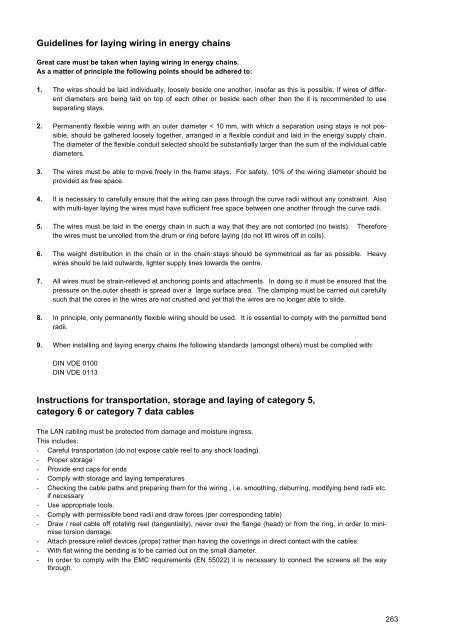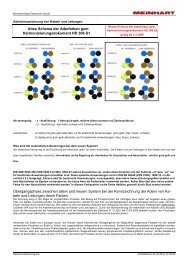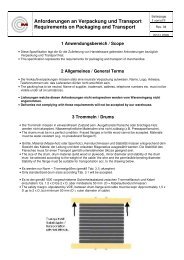CABLES AND WIRES - Meinhart Kabel Österreich Gmbh
CABLES AND WIRES - Meinhart Kabel Österreich Gmbh
CABLES AND WIRES - Meinhart Kabel Österreich Gmbh
You also want an ePaper? Increase the reach of your titles
YUMPU automatically turns print PDFs into web optimized ePapers that Google loves.
Guidelines for laying wiring in energy chains<br />
Great care must be taken when laying wiring in energy chains.<br />
As a matter of principle the following points should be adhered to:<br />
1. The wires should be laid individually, loosely beside one another, insofar as this is possible. If wires of different<br />
diameters are being laid on top of each other or beside each other then the it is recommended to use<br />
separating stays.<br />
2. Permanently flexible wiring with an outer diameter < 10 mm, with which a separation using stays is not possible,<br />
should be gathered loosely together, arranged in a flexible conduit and laid in the energy supply chain.<br />
The diameter of the flexible conduit selected should be substantially larger than the sum of the individual cable<br />
diameters.<br />
3. The wires must be able to move freely in the frame stays. For safety, 10% of the wiring diameter should be<br />
provided as free space.<br />
4. It is necessary to carefully ensure that the wiring can pass through the curve radii without any constraint. Also<br />
with multi-layer laying the wires must have sufficient free space between one another through the curve radii.<br />
5. The wires must be laid in the energy chain in such a way that they are not contorted (no twists). Therefore<br />
the wires must be unrolled from the drum or ring before laying (do not lift wires off in coils).<br />
6. The weight distribution in the chain or in the chain stays should be symmetrical as far as possible. Heavy<br />
wires should be laid outwards, lighter supply lines towards the centre.<br />
7. All wires must be strain-relieved at anchoring points and attachments. In doing so it must be ensured that the<br />
pressure on the outer sheath is spread over a large surface area. The clamping must be carried out carefully<br />
such that the cores in the wires are not crushed and yet that the wires are no longer able to slide.<br />
8. In principle, only permanently flexible wiring should be used. It is essential to comply with the permitted bend<br />
radii.<br />
9. When installing and laying energy chains the following standards (amongst others) must be complied with:<br />
DIN VDE 0100<br />
DIN VDE 0113<br />
Instructions for transportation, storage and laying of category 5,<br />
category 6 or category 7 data cables<br />
The LAN cabling must be protected from damage and moisture ingress.<br />
This includes:<br />
- Careful transportation (do not expose cable reel to any shock loading).<br />
- Proper storage<br />
- Provide end caps for ends<br />
- Comply with storage and laying temperatures<br />
- Checking the cable paths and preparing them for the wiring , i.e. smoothing, deburring, modifying bend radii etc.<br />
if necessary<br />
- Use appropriate tools.<br />
- Comply with permissible bend radii and draw forces (per corresponding table)<br />
- Draw / reel cable off rotating reel (tangentially), never over the flange (head) or from the ring, in order to minimise<br />
torsion damage.<br />
- Attach pressure relief devices (props) rather than having the coverings in direct contact with the cables.<br />
- With flat wiring the bending is to be carried out on the small diameter.<br />
- In order to comply with the EMC requirements (EN 55022) it is necessary to connect the screens all the way<br />
through.<br />
263




